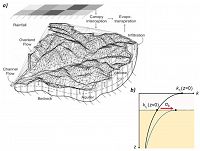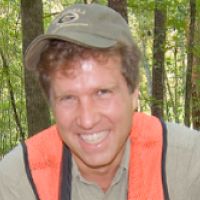tRIBS-ECO
Triangulated Irregular Network-based Real-time Integrated Basin Simulator-Erosion and C Oxidatition
Spatially- and depth-explicit physically-based model of hydro-geomorphic processes and of soil organic carbon dynamics.
Model Category: Numerical
Image: Illustration of modelled hydrological processes at the basin scale in tRIBS (a). In tRIBS-ECO erosion and management practices alter the depth dependent carbon oxidation rate, kt (b).
-
Calhoun, Luquillo, INVESTIGATOR
-
Calhoun, Luquillo, INVESTIGATOR, COLLABORATOR
-
Calhoun, Luquillo, INVESTIGATOR
-
Calhoun, INVESTIGATOR
-
Calhoun, INVESTIGATOR
-
Calhoun, INVESTIGATOR
Episodic soil erosion and deposition play an important role on carbon dynamics, as they are capable of altering the rate of carbon mineralization. Assessing the impact of landscape evolution on soil organic carbon dynamics may provide insights on the net carbon fluxes at basin scale and a critical step in understanding challenges that may be posed by climate change. This study seeks to answer how past erosion in the Calhoun Critical Zone Observatory has redistributed and altered the dynamics of soil organic carbon. This involves complex processes affected by multiple factors such as soil, weather, soil moisture dynamics, and agricultural practice.
The impact of soil erosion and deposition on the dynamics of soil organic carbon can be simulated by using the tRIBS-ECO (Triangulated Irregular Network-based Real-time Integrated Basin Simulator-Erosion and Carbon Oxidation), which is based on an existing coupled hydro-geomorphic model (Francipane et al., 2012; Ivavov et al., 2004). The spatially- and depth-explicit model implements a physically-based approach that stresses the fine dynamics and spatial heterogeneity of episodic carbon erosion and atmospheric carbon sequestration, and systematically tracks the dynamics of eroded soil organic carbon at the watershed scale.
References
Francipane, A., Ivanov, V. Y., Noto, L. V., Istanbulluoglu, E., Arnone, E., & Bras, R. L. (2012). tRIBS-Erosion: A parsimonious physically-based model for studying catchment hydro-geomorphic response. Catena, 92, 216-231.
Ivanov, V. Y., Vivoni, E. R., Bras, R. L., & Entekhabi, D. (2004). Catchment hydrologic response with a fully distributed triangulated irregular network model. Water Resources Research, 40(11).
Publications
2014
Assessing the impact of landscape evolution on carbon dynamics: a coupled physically-based modelling approach. Dialynas, Y. G.; Bastola, S.; Billings, S. A.; Bras, R. L. (2014): American Geophysical Union annual meeting, San Francisco, California, December, 2014
2015
A Coupled Spatially Explicit Modelling Approach to Assess the Influence of Soil Erosion and Deposition on the Redistribution of Soil Organic Carbon at the Watershed Scale. Dialynas, Y. G., Bastola, S., Bras, R. L., Billings, S. A., Richter, D. deB., and Markewitz, D. (2015): 2nd Annual Southeastern Biogeochemistry Symposium, Atlanta, GA, Mar. 28-29, 2015
2016
Topographic variability and the influence of soil erosion on the carbon cycle. Dialynas, Y. G., S. Bastola., R. L. Bras, S. A. Billings, D. Markewitz, and D. deB. Richter (2016): Global Biogeochemical Cycles 30(5): 644-660
2015
Topographic variability in the influence of soil erosion on the carbon cycle. Dialynas, Y. G., Bastola, S., Bras, R. L., Billings, S. A., Richter, D. deB., and Markewitz, D. (2015): Calhoun CZO 2015 Summer Science Meeting
2015
Coupling of Carbon-Nitrogen cycle on a physically based distributed hydrological model, tRIBS. Bastola, S. (2015): Calhoun CZO 2015 Summer Science Meeting
Explore Further







